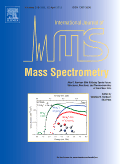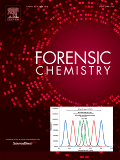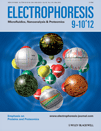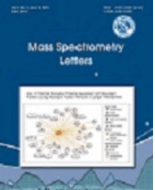
INTERNATIONAL JOURNAL OF MASS SPECTROMETRY
Scope & Guideline
Pioneering Discoveries in Mass Spectrometry Techniques
Introduction
Aims and Scopes
- Fundamental Research in Mass Spectrometry:
This area encompasses the theoretical development and experimental studies that enhance the understanding of mass spectrometric principles, including ionization methods, fragmentation processes, and instrumentation improvements. - Analytical Applications of Mass Spectrometry:
Research that applies mass spectrometry for quantitative and qualitative analysis in fields such as pharmaceuticals, environmental science, and biochemistry, focusing on method development and validation. - Emerging Techniques and Instrumentation:
The journal emphasizes the development of novel mass spectrometric techniques and instruments, such as ion mobility spectrometry, ambient ionization techniques, and miniaturized mass spectrometers. - Interdisciplinary Research:
The journal promotes studies that integrate mass spectrometry with other scientific disciplines, including biology, chemistry, and materials science, showcasing its versatility in addressing complex research questions. - Methodological Advancements and Optimization:
Research focused on improving existing mass spectrometric methods, enhancing sensitivity, resolution, and throughput, as well as novel data analysis techniques, is a core area of the journal.
Trending and Emerging
- Portable and Miniaturized Mass Spectrometry:
Recent publications indicate a growing interest in developing portable mass spectrometers for on-site analysis, particularly in fields such as environmental monitoring, clinical diagnostics, and forensics. - Integration of Mass Spectrometry with Data Science:
The application of machine learning and advanced data analysis techniques to mass spectrometric data is emerging as a significant trend, enhancing the interpretation of complex datasets and improving method optimization. - Multi-Dimensional and Hybrid Mass Spectrometry Techniques:
There is an increasing focus on multi-dimensional approaches that combine mass spectrometry with other separation techniques, such as chromatography and ion mobility spectrometry, to improve resolution and sensitivity. - Biological and Proteomic Applications:
Research centered on the application of mass spectrometry in proteomics, metabolomics, and biomolecular studies is on the rise, reflecting the growing importance of mass spectrometry in understanding biological systems. - Sustainable and Green Chemistry Approaches:
Emerging themes in sustainable mass spectrometry practices are gaining traction, including the development of environmentally friendly ionization methods and the analysis of green chemistry processes.
Declining or Waning
- Traditional Mass Spectrometry Techniques:
There has been a noticeable decrease in publications focused solely on conventional mass spectrometry techniques, as researchers increasingly explore innovative ionization methods and hybrid systems that combine multiple analytical approaches. - Isotope Ratio Studies:
Although still important, studies specifically dedicated to isotope ratio measurements have become less frequent, possibly due to advancements in more precise and versatile techniques that allow for broader applications. - Basic Ion Chemistry:
Research primarily centered on fundamental ion chemistry has seen a decline, as the field shifts towards more applied and interdisciplinary studies that connect mass spectrometry with broader scientific inquiries. - Environmental Monitoring Using Mass Spectrometry:
While environmental applications remain relevant, the frequency of dedicated studies in this area has diminished, likely due to the rise of integrated approaches that combine mass spectrometry with other analytical techniques. - Single-Target Analysis:
There is a decreasing trend in publications focusing on single-target analysis in mass spectrometry, as researchers are moving towards multiplexed and high-throughput methodologies that allow for the simultaneous analysis of multiple analytes.
Similar Journals

Acta Chemica Iasi
Empowering Global Research in Chemical SciencesActa Chemica Iasi is a distinguished open-access journal dedicated to advancing the field of chemistry, published by the esteemed ALEXANDRU IOAN CUZA UNIVERSITY PRESS located in Iasi, Romania. Since its inception, this journal has served as a vital platform for the dissemination of significant research findings, theoretical advancements, and methodological innovations in various chemistry disciplines. As an open-access publication since 2013, it provides unrestricted access to high-quality articles, fostering collaboration and knowledge sharing among researchers, professionals, and students globally. Although specific metrics such as H-Index and Scopus rankings may be forthcoming, the journal's commitment to rigor and excellence ensures that it remains an invaluable resource for those seeking to stay at the forefront of chemical research. With a focus on promoting scientific inquiry and innovation, Acta Chemica Iasi continues to uphold a legacy of scholarly excellence and contribution to the chemical sciences.

Analytical and Bioanalytical Chemistry Research
Empowering Global Knowledge in Chemistry.Analytical and Bioanalytical Chemistry Research is an esteemed open-access journal published by the Iranian Chemical Society, dedicated to the advancement of knowledge in the fields of analytical chemistry, biochemistry, and spectroscopy. Since its inception in 2014, this journal has provided a platform for researchers, professionals, and students to publish and access high-quality research articles that contribute to the understanding of chemical analysis and bioanalytical methods. With an ISSN of 2383-093X and an open-access model that promotes global dissemination of findings, it ensures that innovative research reaches a broad audience. The journal has consolidated its presence in the scientific community, currently ranked in quartile Q4 for analytical chemistry, biochemistry, and spectroscopy as of 2023. Its Scopus rankings, including a percentile of 34th in Analytical Chemistry, reflect its commitment to quality research and scholarly contribution. Situated in Tehran, Iran, the journal serves as a vital resource for academic discourse, offering insights into emerging trends and methodologies in analytical and bioanalytical chemistry.

ANALYTICAL AND BIOANALYTICAL CHEMISTRY
Advancing the Frontiers of Chemical AnalysisANALYTICAL AND BIOANALYTICAL CHEMISTRY, published by SPRINGER HEIDELBERG, is a leading international journal that serves as a vital platform for innovative research in the fields of analytical and bioanalytical chemistry. With an impressive impact factor and ranking in the Q2 category for both Analytical Chemistry and Biochemistry, the journal highlights key advancements and methodologies that drive the discipline forward. Established in 1996 and continuing vigorously into 2024, it has gained significant recognition with Scopus rankings placing it in the 83rd and 78th percentiles within its categories, underscoring its impact and relevance. The journal's commitment to open access facilitates widespread dissemination of critical scientific knowledge, making it an essential resource for researchers, professionals, and students dedicated to exploring the complexities of chemical analysis. With its base in Heidelberg, Germany, ANALYTICAL AND BIOANALYTICAL CHEMISTRY continues to inspire and influence the global research community.

Studia Universitatis Babes-Bolyai Chemia
Exploring New Frontiers in ChemistryStudia Universitatis Babes-Bolyai Chemia, published by UNIV BABES-BOLYAI in Romania, serves as a pivotal platform for the dissemination of innovative research in the field of chemistry. With an ISSN of 1224-7154, this journal has been actively publishing since 2009 and aims to foster scientific collaboration and knowledge sharing among researchers, professionals, and students alike. Although currently categorized in Q4 of the Chemistry (miscellaneous) field, the journal provides an essential venue for emerging studies that contribute to the diverse landscape of chemical research. With its commitment to accessibility and scholarly discourse, Studia Universitatis Babes-Bolyai Chemia remains an important resource for those seeking to stay abreast of the latest developments and trends in general chemistry, holding a Scopus rank within the lower quartiles. Researchers and practitioners are encouraged to engage with its content to enrich their own work and to aid in the advancement of the scientific community.

Forensic Chemistry
Unveiling truths with cutting-edge forensic analysis.Forensic Chemistry is a premier journal published by Elsevier, specializing in the interdisciplinary field of forensic science, with a strong emphasis on analytical and materials chemistry, pathology, and law. Established in 2016 and converging to a significant publication trajectory through 2024, the journal has rapidly ascended to an impressive Q1 ranking across multiple categories, demonstrating its impact and commitment to advancing forensic analysis and methodologies. With an impact factor reflecting its relevance—especially notable with a 95th percentile rank in Social Sciences and Law—Forensic Chemistry serves as an essential resource for researchers, legal authorities, and academics seeking to explore the latest developments in forensic techniques and applications. Its rigorous peer-review process and high-quality publications ensure that it remains at the forefront of scientific inquiry in forensic practices. Access to the journal is available without an open access model, further emphasizing its commitment to curated, high-impact scholarship that contributes to both theoretical foundations and practical applications in the forensic field.

Molbank
Exploring the Frontiers of Biochemistry and BeyondMolbank is an open-access journal published by MDPI, dedicated to the fields of Biochemistry, Organic Chemistry, and Physical and Theoretical Chemistry. Established in 2002, this journal has served as a vital platform for the dissemination of research findings, where researchers and professionals share original articles focusing on molecular chemistry, synthesis, and related studies. With a commitment to open access, Molbank enables global access to scientific knowledge, fostering collaboration and innovation among scientists. While currently categorized in the fourth quartile for its field rankings, it provides a unique opportunity for emerging scholars to contribute to and engage with the scientific community. The journal is based in Switzerland, operating from its office at ST ALBAN-ANLAGE 66, CH-4052 BASEL, SWITZERLAND, and continues to attract submissions until 2024. Researchers, students, and professionals looking to expand their knowledge and participate in the dialogue of current molecular chemistry can benefit significantly from engaging with the content published in Molbank.

Separation Science Plus
Connecting scholars to the forefront of separation innovation.Separation Science Plus is an emerging academic journal dedicated to advancing the field of analytical chemistry and separation science. Published by WILEY-VCH Verlag GmbH, this journal provides a platform for researchers to disseminate high-quality studies and reviews that address innovative techniques and breakthroughs in separation methodologies. With its ISSN 2573-1815, the journal has made significant inroads since its inception in 2018, encompassing a convergence period until 2024. Despite currently holding a Q3 ranking in Analytical Chemistry and a Q4 ranking in Filtration and Separation, its dedication to publishing impactful research makes it a vital resource for professionals and students alike. The journal operates under the robust scholarly reputation of WILEY, which is known for its commitment to excellence in scientific communication. Researchers interested in the latest advancements in separation techniques will find Separation Science Plus an essential read, fostering the exchange of knowledge and facilitating greater understanding within this specialized field.

ELECTROPHORESIS
Driving Insights in Clinical BiochemistryELECTROPHORESIS, published by Wiley, stands as a premier journal dedicated to advancing the field of analytical chemistry, biochemistry, and clinical biochemistry. With an ISSN of 0173-0835 and an E-ISSN of 1522-2683, this journal has been a vital resource since its inception in 1980 and is poised to continue its journey through to 2024. Operating out of Germany, it holds a significant standing in the academic community, featuring in the Q2 category for Analytical Chemistry and in the Q3 tier for both Biochemistry and Clinical Biochemistry as of 2023. The journal ranks impressively within Scopus, occupying the 43rd position out of 156 in Analytical Chemistry and the 44th spot out of 117 in Clinical Biochemistry, ensuring its relevance and impact in these disciplines. Although it does not currently offer open access, ELECTROPHORESIS remains an essential publication for researchers, professionals, and students seeking cutting-edge insights and developments that influence the methodologies and technologies underpinning electrophoretic techniques.

Mass Spectrometry Letters
Empowering Researchers through Open Access Discoveries.Mass Spectrometry Letters is a pioneering open-access journal published by the Korean Society for Mass Spectrometry, specializing in the diverse fields of analytical chemistry, biochemistry, and spectroscopy. Established in 2010, this journal aims to disseminate groundbreaking research and advancements in mass spectrometry and its applications across various scientific domains. Though currently categorized in the Q4 quartile in key analytical fields, Mass Spectrometry Letters serves as an essential platform for researchers, professionals, and students to share innovative methodologies, emerging trends, and practical applications of mass spectrometry, thus fostering collaboration and advancing knowledge in the scientific community. With a commitment to open access, articles published since 2010 are readily available, enabling widespread distribution and engagement within the international research community. Located in Daejeon, South Korea, and actively converging research through 2024, the journal holds the potential to grow its impact and relevance within the dynamic landscape of mass spectrometry.

JOURNAL OF ANALYTICAL CHEMISTRY
Connecting Minds in the World of Analytical ChemistryJOURNAL OF ANALYTICAL CHEMISTRY, published by PLEIADES PUBLISHING INC, stands as a pivotal resource in the field of analytical chemistry, offering an innovative platform for researchers, professionals, and students to advance their knowledge and contribute to the discourse within the discipline. With an ISSN of 1061-9348 and an E-ISSN of 1608-3199, this journal features a focused exploration of analytical methodologies, instrumentation developments, and applications across various domains, contributing to practical and theoretical advancements in the field. Currently ranked in the Q3 category in Analytical Chemistry with a Scopus rank of #111 out of 156, it provides critical insights and innovation strategies for professionals aiming to enhance their analytical capabilities. Access to the journal is through standard subscription models, and it covers an extensive range of topics pertinent to the discipline from 1996 to 2024. Engage with the JOURNAL OF ANALYTICAL CHEMISTRY to be part of a vibrant research community dedicated to push the boundaries of analytical practices.